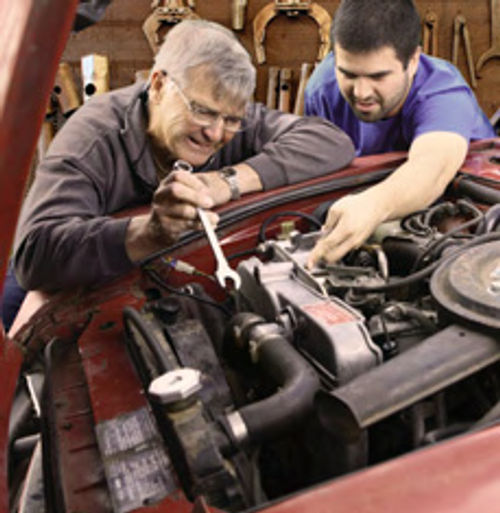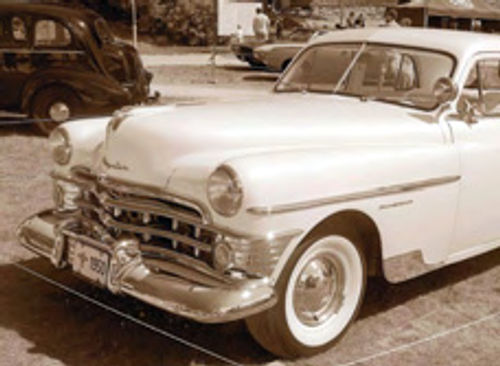Reader Follow-up
A Professor of Automotive Service Technology Takes It On, and Offers an Organized Approach to Its Diagnosis.
Editor’s note: In our November issue reader Peter Biebel told us that he had placed a brand-new GM crate engine in his 1998 Pontiac Bonneville and during the first four months of operation he had roughly 15 instances where the “check engine” light came on. Yet when he took the car to a mechanic, the computer showed no problem codes. Some months later the car stalled twice while he was driving it and again the computer showed no problem codes.
We had several reader letters on the subject in last month’s issue and we also received this in-depth look at the situation from Mike Foss, professor/coordinator with the Automotive Service Technology program at College of DuPage in Glen Ellyn, Illinois (near Chicago). We’ll have more about Mike and DuPage at the end of his article.
FIRST OFF, I would like to commend you guys on the great job you are doing for the restoration community. I enjoy every magazine and am always interested in the problems folks have in the restoration of their favorite vehicles…keep up the good work.
With all of that said, I would like to add my two cents’ worth on the November Mechanic on Duty entry regarding a 1998 Pontiac Bonny belonging to Peter Biebel. Please…please do not replace the computer YET.
Peter does not say if he replaced the engine or he paid a technician and/or shop to do the replacement so I have no idea of Peter’s talent level.
Possible Problems
Depending on Peter’s willingness to get his hands dirty, I would like to pass along to him my suspicions. I believe his problem is a power or ground issue. Since the engine was replaced I would start with the grounds.
General Motors—since the 1980s and the start of computers—has used what I call a “studded bolt” for the ground from the battery and to the computer. Sometimes on the same studded bolt. I have seen this before in more than one scenario. I will start with the easiest solutions and work to the more difficult.
It could be just loose—very common and a quick fix. It could be dangling— yes, it would run but when turning a corner it would not. Or, pinched between the bell housing and the engine block— not as likely but worth investigating. And lastly on my list, a broken ground wire for the computer making an intermittent connection—this will drive you crazy and is the most difficult to find.
I believe his problem is a power or ground issue. Since the engine was replaced, I would start with the grounds.
I know what you are thinking… wouldn’t that set a code? Well, yes, it could (would) but some scan tools and code readers (and technicians, I might add) will ignore the code known as a PO 1000—loss of battery power. It takes a sharp technician to pick up on this and apply it to the customer’s complaint. The sharp technician would look to see if the “monitors” have reset with the scan tool. The computer runs self-diagnostics while the car is driving and will set a “monitor” to “ready.” If it loses power the monitors will reset to “not ready,” indicating a loss of power.
A momentary loss of power to the computer will give the driver the feeling that someone turned off the ignition…and really it did.In the milliseconds it takes for the driver to look down at the dash the connection reconnects and all the lights come on including the “Check Engine” light. The power steering problem, if I understand Peter correctly, is caused by the loss of engine power during a turn and I would ignore that problem forNOW.
Follow That Wire…
Now, if Peter is ready to get his hands dirty...here we go. Start at the battery and physically run your hand down the battery ground wire to the engine block. But first I should add if this Bonny has one of those cut-and-strip battery cable repair ends (positive or negative)…Peter needs a new battery cable(s). If it does not fix the problem it needed it anyway. Those cut-and-strip things are a no crank/no-start problem waiting to happen; never mind the drivability issues they can cause with a computer on board.They MIGHT work OK on a 1957 Chevrolet but not on a computer car.
Give the cable a slight tug. I have seen factory cables that look good and are tight on the battery and yet they come right out of the cable end when given a little tug. If the cable is tight at the battery, run down the wire to the back of the bell housing. Is the bolt tight in the block…no…then loosen the nut on the back of the studded bolt and tighten the bolt into the block (there is a torque specification I am sure…check your shop manual), then tighten the nut making sure the star lock washer is in place along with all of the wires—the battery cable, and more than likely two to three more 14-gauge wires, likely black. If the nut was loose…tighten it but pay attention to the bolt going into the engine. If it starts turning while you tighten the nut, back up and do the prior. If either was loose…it’s time for a test drive.
Loose wire problems are best diagnosed on rough roads or on an abandoned railroad spur track. I think you know why I say abandoned tracks only!
That was the easiest…now on to the harder approach.
To find the dangler and pinched, you may need to remove some stuff to look at the back of the engine and the bell housing area…your eyes are your best tools…look around…does something look out of place?
You say you’ve found a dangling wire, most likely black…uh, that is your ground for the computer (most likely), hook it up to the studded bolt and tighten…and remember the star washer.
If you see a wire going into the bell housing…uh… that doesn’t belong there! Two things you can do…loosen all the bell housing bolts and pull the wire out, repair it and install it where it belongs on the studded bolt or you can cut the wire and install an eyelet (wire end). I would solder it although some would say no, and install it on the studded bolt. If everything looks good, then the wire is broken and this requires the patience of a saint and some real test equipment… being a contortionist doesn’t hurt, either.
At that point I would say Peter needs an ASE (Automotive Service Excellence) certified technician and a shop like Richard Prince suggests in the Mechanic On Duty article.
It Could Be a Question of Power
The positive side of the wiring could have a similar problem but it’s a lot more complicated to work it out.
If Peter wants to, he can apply techniques similar to those he used on the ground side to diagnose the power side…but like I say, it’s more complicated. On the positive side he will require a wiring diagram for the car from the shop manual.
Broken wires are always a possibility on a 13-year-old car that has had some major repairs completed.
Now, the easiest is the wires from the top terminal on the starter solenoid. They are most likely not loose because if that were the case, Peter should be complaining about a poor starter condition.
Broken wires are always a possibility on a 13-year-old car that has had some major repairs completed.
Peter needs to realize, if he doesn’t already, on a computer-controlled car there are 10 to 30 wires connected to the engine and they ALL have to be removed to install a new engine. All of the above-mentioned problems are possible and even more that I do not have time or space to go into here.
My parting caution is that the computer on this Bonny will need to be programmed IF it is the culprit.
Some auto parts stores will program it for you but there will be a charge and a waiting time. The auto parts store will need the VIN, and maybe some other information in order to program it.
Make certain that this is the problem before going ahead with computer programming because like any electrical part once you bought it, you own it…and there are no returns.
We also asked Mike to talk about the automotive program at DuPage, and here’s his reply:
The program here at College of DuPage (a community college), in Glen Ellyn, Illinois, is geared toward training future professional auto technicians. We offer a Certificate, with automotive classes only, and a Degree program, which adds general education classes, i.e. math,science, English,social science and humanities. The certificate will take about a year and a half and the degree will take about two years.
We are certified by the National Automotive Technicians Education Foundation(NATEF),adivisionofASE.(NATEF certifies training programs and ASE certifies technicians.)
The program is broken down into the same areas as the ASE certification exams: engine repair, electrical, steering suspension-alignment, HVAC, engine performance, brakes, and manual and automatic transmissions. The classes have few prerequisites (where you have to take a class to take another class) and can be taken in any order. We do have students that take one class to work on their classic car and we will not see them for a year and all of a sudden they are back for another class. (I affectionately call them “hobby shoppers.”)
Our lab has 30 bays plus a bay in 3 classrooms…the building that our lab is located in is 1.5 years old.
We have an educational fleet of 40+ vehicles ranging from a 1990 Mercury Grand Marquis to a 2007 Dodge 2500 4x4 Cummins with some Ford hybrids mixed in for good measure. All of these vehicles are used during class time for hands-on training.
My dad and I have a fleet of 20 collector cars that keep me busy on the weekends.
I personally have been interested in anything with four wheels and a steering wheel since I was eight years old. My dad and I have a fleet of 20 collector cars that keep me busy on the weekends. Our fleet ranges from a 1939 Chevrolet Master Deluxe to a 2006 Chrysler PT Cruiser (daily driver) plus some old lawn and farm tractors just for fun.
For more about the College of DuPage, visit cod.edu.


















